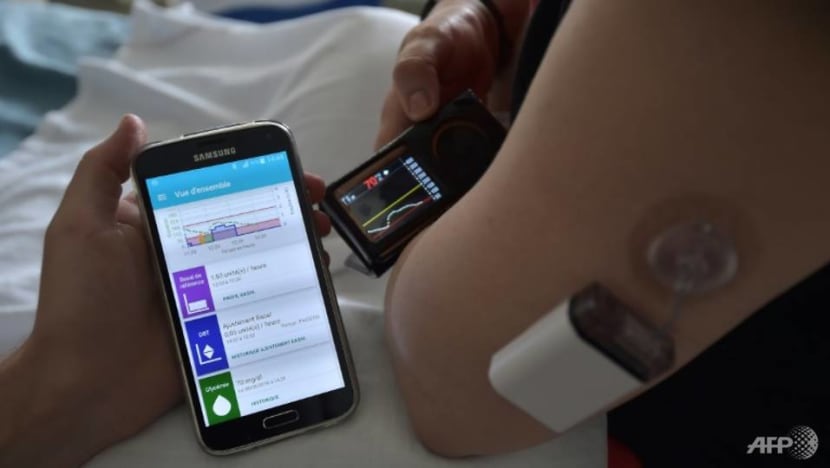commentary Commentary
Commentary: Making a trip to the clinic is not the only way to get medical treatment during COVID-19
More people with routine or chronic health conditions have turned to health tech if they cannot or are reluctant to attend a clinic or hospital, says Ashish Oza.

Tele-health at Tan Tock Seng Hospital (TTSH). (Photo: TTSH)
SINGAPORE: COVID-19 is unprecedented in every way, but what’s been striking about the disruption is that almost everyone, young and old, has had a price to pay.
Children have had to miss school or playing in parks with their friends, livelihoods have been lost, money has been stuck in cancelled flight tickets, expected returns on investments have been disappointing, weddings have had to be called off, families have been distanced and the elderly have been isolated even further – each of us has a story to tell.
But even as Singapore has entered the second phase of its reopening, it is too soon to declare that life will be the same as before the pandemic.
The world will need to continue to live with the sudden and unplanned changes brought on by the coronavirus.
READ: Commentary: Here's how our elderly can better protect themselves against COVID-19
And while some restrictions have been eased since Jun 19 – including the resumption of health services - safe distancing measures will largely remain.
The rapid rise of COVID-19 infections has caused an overload on healthcare systems as frontline workers focused on the immediate crisis.
The experience can weigh on those managing chronic health conditions since many have been unable to attend, or decided to stay away from, their doctor’s clinic or hospital to keep safe.
For patients with heart rhythm problems, progressive heart failure or chronic conditions, regular follow-ups are crucial to monitor their health and adjust prescribed medication, but the pandemic has upended that.
Health tech has stayed a step ahead, helping people with routine or chronic health conditions to stay in touch with their doctors – even if they cannot, or are reluctant to, attend a clinic or hospital.
READ: Commentary: Record dengue cases complicates Singapore's fight against COVID-19
And while cutting-edge technology used in diverse fields from communications systems to jet engines is helping patients and their doctors to uncover actionable insights into their health, tele-health is the glue that holds everything together.
TELE-HEALTH IS HEALTHCARE’S NEW SOCIAL PLATFORM
Technology is bringing healthcare closer to patients and consumers at a time when safe distancing has become a part of daily life.
As nations battle to keep the virus at bay, tele-health is a powerful tool because it helps doctors to connect with patients in hospitals, clinics and at home, much like what social media did for a lot of us, over a decade ago.

Better bandwidth has allowed technology to be applied to many inpatient and outpatient specialties allowing people to access healthcare services through video, telephone, chat and messaging enabled by mobile apps and websites.
As people avoid visiting clinics because of fears about COVID-19, Singaporeans are increasingly opting for online consultations, as evidenced by a huge spike in signups to telemedicine platforms over the past couple of months.
Daily calls from patients to tele-health service providers such as MyDoc, MaNaDr, WhiteCoat and Doctor Anywhere have surged - by up to five times for some.
These platforms allow quick diagnoses without the need to physically visit a doctor’s clinic.
Online consultations range from routine follow-up sessions for chronic diseases such as diabetes and even the assessment of urgent COVID-19-like symptoms.
REMOTE CARE SUPPORTS CHRONIC HEALTH CONDITIONS
Diabetes is a condition with a prevalence of around 9 per cent in Singapore, according to 2017 data from the Ministry of Health.
Since less than a third of people diagnosed with diabetes are able to achieve desired glycaemic goals - a key factor in effective and long-term management of diabetes - regular and timely follow-ups with the treating physician are important.
But face-to-face consultations can be challenging during this time.
That’s why continuous glucose monitoring technology - used by people with diabetes to check their glucose levels - connected to digital tools like mobile apps and cloud-based data systems has proven vital.
READ: Commentary: Tai chi ought to be encouraged – it's not just the physical health benefits
The past few weeks of restrictions on movement due to COVID-19 have coincided with the rise of adoption in cloud-based digital monitoring tools. For instance, Abbott has seen a significant spike in users adopting FreeStyle Libre’s cloud-enabled diabetes management tool, which allows doctors to remotely review a patient’s glucose levels.
CONNECTIVITY POWERS JET ENGINE HEART TECH
For people with heart-failure, quick access to medical care is a necessity.
As COVID-19 has impacted health systems around the world, it has also been important to help heart failure patients avoid exposure to the virus in places such as hospitals or clinics. New technology can help solve both problems.
Technology used in jet engines has led to innovations such as Cardio Micro-Electrical Mechanical Systems, which are in use across the US, Europe and some Asian countries.
These can detect changes in the pressure of blood through the pulmonary artery in heart failure patients - even before symptoms such as shortness of breath or weight gain become evident.
READ: Commentary: Here’s how to get TraceTogether downloads up – without making it mandatory
The system features a small pressure-sensing device that is implanted directly into the pulmonary artery. It sends information wirelessly to a doctor so that it can be used to adjust a patient’s medications and treatment plan, if needed.
The technology is proven to significantly reduce heart-failure hospital admissions by 58 per cent over an average of 12 months – ultimately improving quality of life.

By helping to keep more heart failure patients out of the hospital, physicians also help patients with a challenging COVID-19 comorbidity avoid potential contact with the virus.
TECHNOLOGY AS A BRIDGE
A person’s quality of life has never had more significance than at the present time.
COVID-19 is arguably one of the biggest challenges that many of us have ever faced. To some, this may even seem as ‘the worst of times’.
But in this season of worry and concern, health tech harbours hope.
In this changed world where distancing is an unexpected, unwelcome intruder and will be with us for many months, innovations in health tech will keep us safe, connected and empowered, paving the way to better times.
BOOKMARK THIS: Our comprehensive coverage of the novel coronavirus and its developments
Download our app or subscribe to our Telegram channel for the latest updates on the coronavirus outbreak: https://cna.asia/telegram
Ashish Oza is Senior Director of Clinical Operations (APAC) at Abbott.














